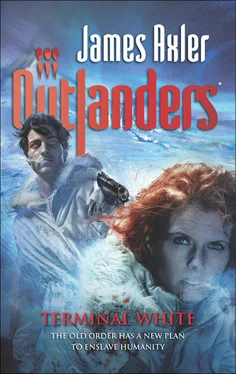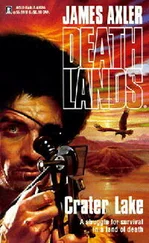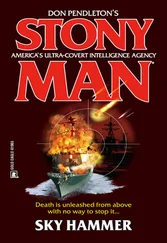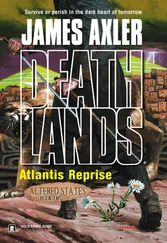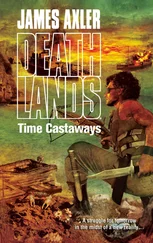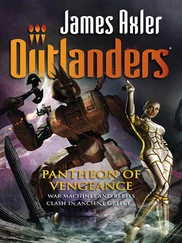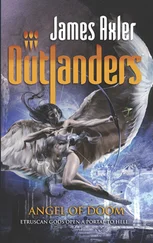—From the journal of Citizen 619F.
Chapter 5
“Storm,” Brewster Philboyd announced emotionlessly.
“Storm,” Lakesh agreed.
The two of them were sitting in office chairs in the Cerberus operations room. The room was a vast space with high ceilings and pleasing indirect lighting. Two aisles of computer terminals faced a giant screen on which material could be flagged. A giant Mercator map dominated one wall, showing the world before the nukecaust had reshaped the coastlines of North America and other locales. The map was peppered with glowing locator dots, which were joined to one another with dotted lines of diodes, creating an image reminiscent of the kind of flight maps that airlines had given to passengers in the twentieth century. The indicated routes were not flight paths, however, but rather they showed the locations and connections of the sprawling mat-trans network. Developed for the US military, the majority of the units were located within North America, but a few outposts could be seen farther afield.
A separate chamber was located in one corner of the room, far from the entry doors. This chamber had reinforced armaglass walls tinted a coffee-brown color. Within was contained the Cerberus installation’s mat-trans unit, along with a small anteroom which could be sealed off if necessary.
Right now the mat-trans chamber was empty but the main ops room was buzzing with activity.
“Big one, too,” Philboyd said as he enhanced the satellite image on his screen, giving a wider view of the storm over British Columbia. Philboyd was a tall, lanky man who seemed somehow hunched over whenever he sat in the standard office furniture of the ops room. His blond hair was swept back and slightly receding while the skin on his cheeks showed evidence of acne scarring from his youth. Philboyd wore round spectacles with dark frames and was a physicist of some good standing. Like many of the personnel who populated the Cerberus redoubt, Philboyd was a transplant from the twentieth century, part of a research project that had been located on the Manitius Moon Base. After the nukecaust had struck, the moon base had gone into lockdown, plunging its staff into cryogenic deep freeze and retaining that expertise for another generation. It had taken a Cerberus exploration party to discover and relocate them to the redoubt.
Lakesh looked at the monitor screen where the satellite feed was playing out. It showed a desolate area of the territory that had once been Canada, around the point where Alberta met British Columbia. The area was white with fallen snow, a few clumps of trees visible as dark shadows on the ground. There was no sign of human habitation; any roads or tracks cutting through the land had been painted white with snow. In the midst of this desolate wasteland was a whirling blur of cloud, feeding the land with ice crystals. It was a small, isolated shower but it still covered several miles. “I didn’t expect the storm to still be raging,” Lakesh muttered, shaking his head.
“No housing nearby,” Philboyd observed, twiddling the image control dial to pull out farther from the storm. “Closest settlement is approximately ninety miles away. If this is your storm, it’s not affecting anyone other than the moose and squirrels.”
Lakesh rubbed his forehead, deep in thought. “Storms move,” he said. “Can we trace its path, backtrack to see if it has caused any devastation?”
Philboyd looked quizzically askance at Lakesh. “With respect, Doctor, I understood that what we were looking for was a past event. This storm is happening very much now.”
“It is,” Lakesh agreed, still thinking, “but hurricanes and tropical storms can rage for days, even weeks.”
Philboyd widened his search area, scanned for signs of devastation. There was nothing obvious—if the storm had destroyed anything it was obscured by the clouds.
Lakesh was still thinking, working through the possibilities in his incisive, analytical mind. “What are those clouds hiding, Mr. Philboyd?” he pondered.
Philboyd didn’t answer, but merely tapped a few commands into his computer keyboard and brought up a surveillance map showing the area. The map showed in a separate window on-screen and it was blank. “Nothing,” he said. “Just wilderness.”
Lakesh bent closer to the screen, studying the map. “Not wilderness,” he decided. “It’s too flat for that.”
“Sir?”
“Brewster—can we backtrack this image twenty-four hours, say?” Lakesh asked. He knew that they could; the satellite would have made a sweep over this area one day before. He was already beginning to suspect something, although he couldn’t put his finger on what.
Philboyd pulled up the records, ran the surveillance footage from one day before. Its time stamp glowed in the lower left corner as it played, moving slowly across the area which Lakesh and Philboyd were looking at now in a standard sweep. As it crossed the particular spot they had been observing, Philboyd let out a surprised laugh.
Lakesh did not laugh, however. What they were looking at, remarkable as it seemed, was what appeared to be the very same storm playing out in the very same spot.
“That’s one persistent storm,” Philboyd stated.
Lakesh pointed to the screen. “But not crossing here, or here,” he said. “It’s fixed to one location. Brewster—take us back another day.”
A few taps of his keyboard and Philboyd had called up the older footage. Once again, the storm was in the exact same spot. They went back further over the next two hours, checking the records going back not just weeks but months. The surveillance satellite had monitored this point every day as part of its routine sweep pattern, and every day showed the same clouds in place. On some days, it would be sunny around the storm, while on others it would be so cloudy all around that they could not pick out the specific clouds that made up the storm. But over time, Lakesh and Philboyd reached the somewhat unsettling conclusion that here, on one single point on the planet, the same storm had been playing out for not just months but possibly years.
“A never-ending storm,” Lakesh said with gravity. “Incredible.”
“But not impossible,” Philboyd stated. “The Great Red Spot on Jupiter is the eye of a gigantic storm—the largest in the solar system—and our records suggest it has run for centuries.”
“But on Earth, with our wind patterns and atmospheric changes...?” Lakesh wondered.
“A holdover from the nukecaust?” Philboyd proposed. The nuclear holocaust had done dreadful things to the Earth’s weather patterns. Holdovers were rare but they did occasionally happen, particularly in areas of high radiation.
Lakesh scratched his chin thoughtfully. “What else do we know about this area?” he asked aloud.
“Right now? Not a lot,” Philboyd confirmed. “There has been no reason to pay it particular scrutiny—”
“There’s your reason, Mr. Philboyd,” Lakesh said, pointing at the storm cloud on his screen. “Get scrutinizing.”
* * *
TWO DAYS LATER, the team regathered in the meeting room, where Lakesh and Bry brought them up to speed with what had been discovered.
“The first reference to the coordinates appears in a backup database from Ragnarville, in a file dating back three and a half years,” Lakesh explained. “The reference is minor and the information attached to it encrypted—”
“The file encryption was a beast,” Donald Bry said, taking up the story, “and we had a lot of trouble getting past it. So much so that I decided to run a search on one of the other databases. To my surprise, the same file with the same encryption appeared on the database of Baron Cobalt.”
“Same encryption means no joy, I take it,” Grant observed sourly.
Читать дальше
